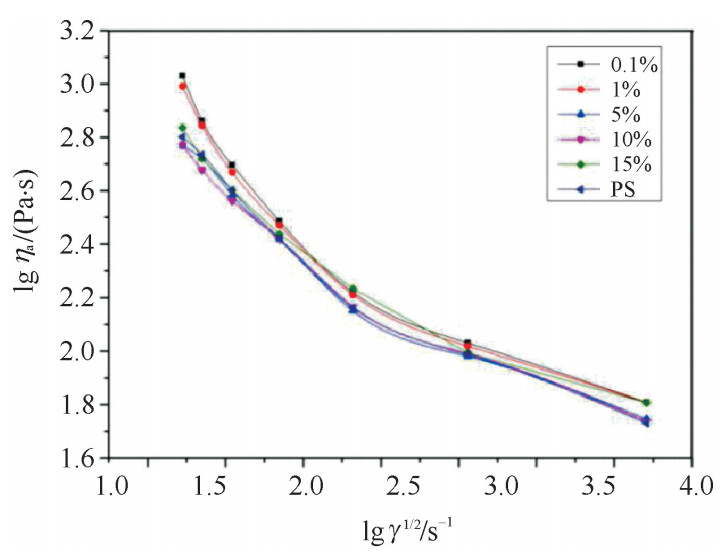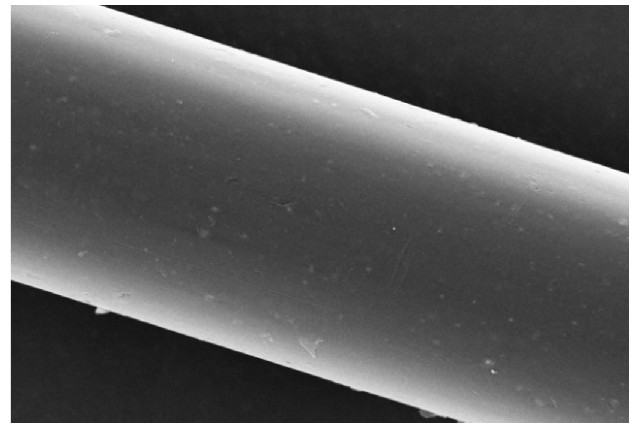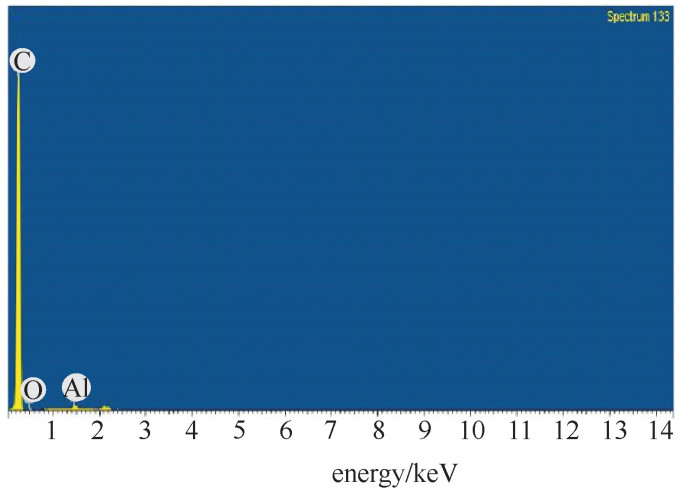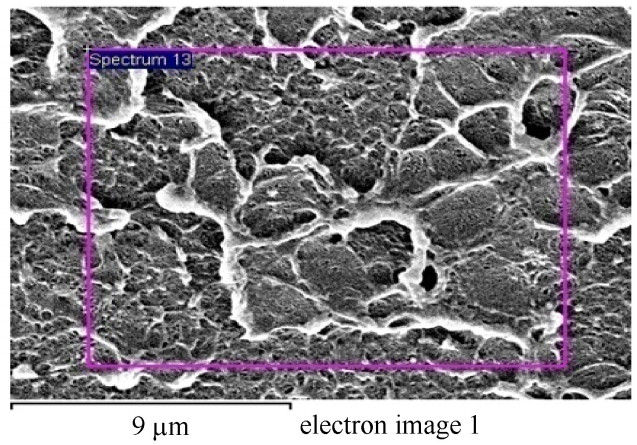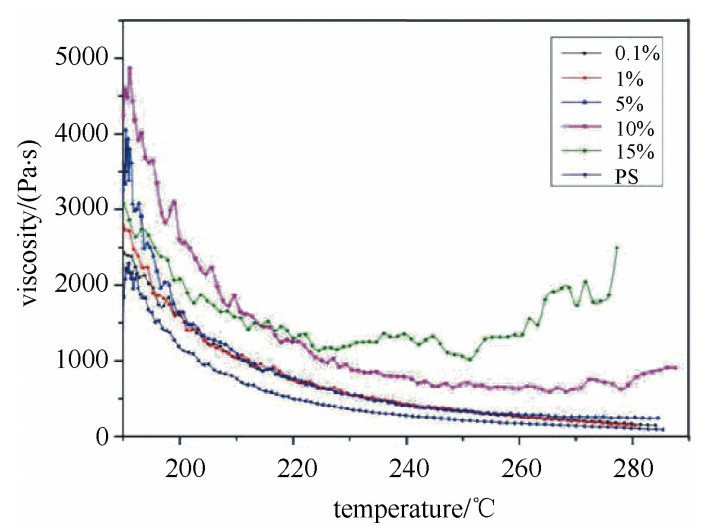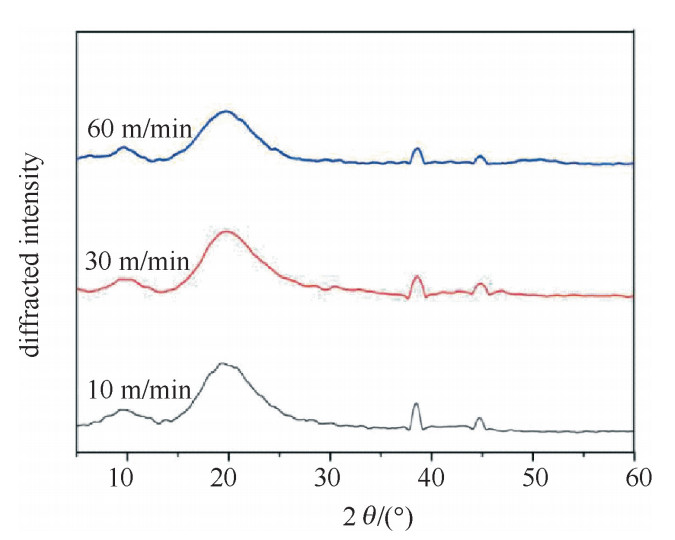Rheological and spinning properties of polystyrene/nano aluminum composites
-
摘要: 为有效制得Z箍缩氘代聚苯乙烯/纳米铝(DPS/AlNPs)导电丝阵材料,采用PS中掺入AlNPs制备PS/AlNPs复合材料纤维进行模拟研究。研究了温度及剪切速率等因素对PS/AlNPs复合材料流变性能的影响、复合材料熔体的结构变化及流动状态与可纺性能的关系,以及PS/AlNPs纤维的形貌、热稳定性能和力学性能。结果表明:PS/AlNPs熔体属于典型剪切变稀型非牛顿流体,熔体的表观粘度与温度呈现负相关,240~260 ℃时复合材料的非牛顿指数介于0.462~0.546,结构黏度系数介于1.8~2.1,黏流活化能介于77.2~104.6 kJ·mol-1,具有良好的可纺性。PS/AlNPs纤维表面光滑,对AlNPs粒子包覆良好且对其抗氧化非常有利,其中当AlNPs质量分数为1%时纤维的断裂伸长率突出、掺量为5%时其断裂强度较高。Abstract: PS/AlNPs composite fibers were prepared by adding AlNPs into PS to finish the simulation study of conductive matrix materials for Z-pinch: deuterated polystyrene/nano-aluminum (DPS/AlNPs). The effects of temperature and shear rate on the rheological properties, the relationship between the structural changes, the flow condition of composites melt and the properties of PS/AlNPs, as well as the morphology, thermal stability and mechanical properties of PS/AlNPs fiber were investigated. The results show that the PS/AlNPs melt is a typical shear thinning non-Newtonian fluid, and the apparent viscosity of the melt is negatively correlated with the temperature. The composite possesses non-Newtonian index of between 0.462 and 0.546 at 240-260 ℃, the coefficient of viscosity of about 1.8 to 2.1, and the activation energy of viscous flow sitting between 77.2 and 104.6 kJ mol-1, showing its good spinnability. The PS shows its ability to coat AlNPs very well and prohibits the AlNPs being oxided, giving birth to a PS/AlNPs fiber possessing smooth surface. The fiber has the biggest elongation at break and the highest breaking strength when the content of AlNPs is 1% and 5%, respectively.
-
Key words:
- nano aluminum /
- polystyrene /
- rheological properties /
- spinning performance /
- composite fiber
-
表 1 240 ℃下PS及PS/AlNPs的流动指数n
Table 1. Non-newtonian index of PS/AlNPs at 240 ℃
content/% n content/% n content/% n 0 0.523 1 0.464 10 0.551 0.1 0.462 5 0.539 15 0.539 表 2 240 ℃时PS/AlNPs的结构黏度指数
Table 2. Structure viscosity index of PS/AlNPs at 240 ℃
content/% Δη content/% Δη 0 2.0 5 1.8 0.1 2.1 10 1.8 1 2.1 15 1.8 表 3 240 ℃时不同掺量PS/AlNPs的黏流活化能
Table 3. Flow activation energy of PS/AlNPs of different dosage at 240 ℃
content/% ΔE/(kJ·mol-1) content/% ΔE/(kJ·mol-1) 0 86.9 5 81.7 0.1 77.2 10 96.0 1 79.7 15 104.6 表 4 PS/AlNPs纤维的结晶度
Table 4. Crystallinity of PS/AlNPs fibers
spinning rate/(m·min-1) crystallinity/% 10 25.68 30 30.83 60 50.93 -
[1] 杨波, 周秀文, 何伟, 等. Z箍缩靶用聚合物丝的弛豫特性[J]. 强激光与粒子束, 2009, 21 (12): 1824-1828. http://www.hplpb.com.cn/article/id/4266Yang Bo, Zhou Xiuwen, He Wei, et al. Relaxation property of polymer filaments used in Z-pinch target. High Power Laser and Particle Beams, 2009, 21(12): 1824-1828 http://www.hplpb.com.cn/article/id/4266 [2] 宦思琪, 程万里, 白龙, 等. 静电纺丝制备聚苯乙烯/纳米纤维素晶体纳米复合薄膜及其性能表征[J]. 高分子材料科学与工程, 2016, 32(3): 141-146. doi: 10.16865/j.cnki.1000-7555.2016.03.026Huan Siqi, Cheng Wanli, Bai Long, et al. Fabrication and characterization of electrospun polystyrene/cellulose nanocrystals nanofibrous films. Polymer Materials Science and Engineering, 2016, 32(3): 141-146 doi: 10.16865/j.cnki.1000-7555.2016.03.026 [3] 黄绘敏, 李振宇, 杨帆, 等. 静电纺丝法制备超细聚苯乙烯纳米纤维[J]. 高等学校化学学报, 2007, 28(6): 1200-1202. doi: 10.3321/j.issn:0251-0790.2007.06.049Huang Huimin, Li Zhenyu, Yang Fan, et al. Ultrafine polystyrene nanofibers prepared by electrospinning. Chemical Journal of Chinese Universities, 2007, 28(6): 1200-1202 doi: 10.3321/j.issn:0251-0790.2007.06.049 [4] 庞月红, 李朝霞, 沈晓芳, 等. 静电纺丝制备聚苯乙烯/石墨烯复合纳米纤维[J]. 化学通报, 2012, 75(11): 1040-1043. https://www.cnki.com.cn/Article/CJFDTOTAL-HXTB201211017.htmPang Yuehong, Li Zhaoxia, Shen Xiaofang, et al. Preparation of polystyrene/graphene composite nanofibers by electrospinning technique. Chemistry, 2012, 75(11): 1040-1043 https://www.cnki.com.cn/Article/CJFDTOTAL-HXTB201211017.htm [5] 管爱枝, 宋义虎, 谭业强, 等. 多壁碳纳米管填充聚苯乙烯复合体系的动态流变特性[J]. 高分子学报, 2011, 2(2): 224-228. https://www.cnki.com.cn/Article/CJFDTOTAL-GFXB201102016.htmGuan Aizhi, Song Yihu, Tan Yeqiang, et al. Dynamic rheological properties of polystyrene/multi-walled carbon nanotubes composites. Acta Polymerica Sinica, 2011, 2(2): 224-228 https://www.cnki.com.cn/Article/CJFDTOTAL-GFXB201102016.htm [6] 王亓超, 于俊荣, 张天, 等. UHMWPE/LLDPE/HBP共混体系流变行为研究[J]. 高科技纤维与应用, 2012, 37(6): 43-47. doi: 10.3969/j.issn.1007-9815.2012.06.009Wang Qichao, Yu Junrong, Zhang Tian, et al. Study on the rheological behavior of ultra-high molecular weight polyethylene/liner low density polyethylene/hyper-branched polyester-amide blends. Hi-Tech Fiber and Application, 2012, 37(6): 43-47 doi: 10.3969/j.issn.1007-9815.2012.06.009 [7] 梁基照. 口型入口角对HIPS熔体流动行为的影响[J]. 合成树脂及塑料, 1995, 12(3): 39-42. https://www.cnki.com.cn/Article/CJFDTOTAL-HCSZ199503008.htmLiang Jizhao. Influence of die angle on the flow behaviour of HIPS melt. China Synthetic Resin and Plastics, 1995, 12(3): 39-42 https://www.cnki.com.cn/Article/CJFDTOTAL-HCSZ199503008.htm [8] 李新法, 张征, 魏爱卿, 等. 氯磺化聚乙烯流变性能研究[J]. 橡胶工业, 2004, 51(9): 521-523. doi: 10.3969/j.issn.1000-890X.2004.09.002Li Xinfa, Zhang Zheng, Wei Aiqing, et al. Study on rheological properties of chlorosulfonated polyethylene. China Rubber Industry, 2004, 51(9): 521-523 doi: 10.3969/j.issn.1000-890X.2004.09.002 [9] 翟元明, 杨伟, 王宇, 等. 分子结构对LLDPE动态流变行为的影响[J]. 高分子材料科学与工程, 2010, 26(1): 88-91. doi: 10.16865/j.cnki.1000-7555.2010.01.025Zhai Yuanming, Yang Wei, Wang Yu, et al. Effects of molecular structures of LLDPE on the dynamic rheological behaviors. Polymer Materials Science and Engineering, 2010, 26(1): 88-91 doi: 10.16865/j.cnki.1000-7555.2010.01.025 [10] Xu Chunju, Liu Guilin, Chen Huiyu, et al. Fabrication of conductive copper-coated glass fibers through electroless plating process[J]. Journal of Materials Science: Materials in Electronics, 2014, 25(6): 2611-2617. [11] Ruphino Z, Edith A, Samson K, et al. Photooxidation of 4-chlorophenol sensitized by lutetium tetraphenoxy phthalocyanine anchored on electrospun polystyrene polymer fiber[J]. Polyhedron, 2012, 33(1): 74-81. [12] Dabrowska I, Fambri L, Pegoretti A, et al. Spinning, drawing and physical properties of polypropylene nanocomposite fibers with fumed nanosilica[J]. Express Polymer Letters, 2015, 9(3): 277-290. [13] Supri A G, Aizat A E, Yazid M I M, et al. Chicken feather fibers-recycled high-density polyethylene composites: The effect of epsilon-caprolactam[J]. Journal of Thermoplastic Composites Materials, 2015, 28(3): 327-339. -





 下载:
下载:
